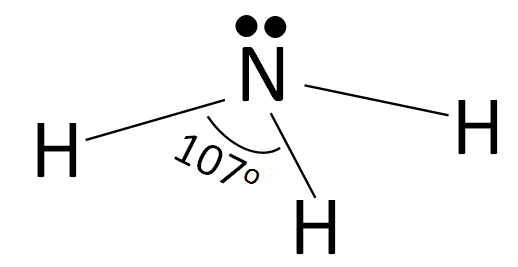
The bond angle of ammonia is
A. True
B. False
Answer
494.1k+ views
Hint: According to the valence bond theory, there exist three
Complete step by step answer:
According to the valence shell electron pair repulsion theory, the structure of ammonia can be drawn as:

According to the structure of ammonia shown above, we can clearly see that the electron lone pair on the nitrogen atom provides repulsion to the
Thus the correct option is B. False.
Note:
To know about the hybridization of ammonia we need to look at the regions around the nitrogen atom. Around the nitrogen atom, there is a lone pair of electrons and 3 sigma bonds which are formed between the nitrogen and hydrogen atoms. Thus, these four regions make ammonia
Complete step by step answer:
According to the valence shell electron pair repulsion theory, the structure of ammonia can be drawn as:

According to the structure of ammonia shown above, we can clearly see that the electron lone pair on the nitrogen atom provides repulsion to the
Thus the correct option is B. False.
Note:
To know about the hybridization of ammonia we need to look at the regions around the nitrogen atom. Around the nitrogen atom, there is a lone pair of electrons and 3 sigma bonds which are formed between the nitrogen and hydrogen atoms. Thus, these four regions make ammonia
Recently Updated Pages
Master Class 4 Maths: Engaging Questions & Answers for Success

Master Class 4 English: Engaging Questions & Answers for Success

Master Class 4 Science: Engaging Questions & Answers for Success

Class 4 Question and Answer - Your Ultimate Solutions Guide

Master Class 11 Economics: Engaging Questions & Answers for Success

Master Class 11 Business Studies: Engaging Questions & Answers for Success

Trending doubts
Give 10 examples of unisexual and bisexual flowers

Draw a labelled sketch of the human eye class 12 physics CBSE

a Tabulate the differences in the characteristics of class 12 chemistry CBSE

Differentiate between homogeneous and heterogeneous class 12 chemistry CBSE

Why is the cell called the structural and functional class 12 biology CBSE

Differentiate between insitu conservation and exsitu class 12 biology CBSE




